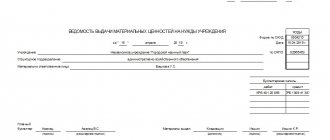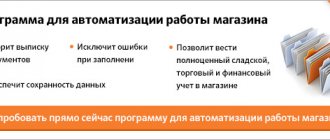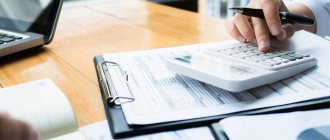Account 16 “Deviation in the cost of material assets” is used by organizations that reflect the cost of inventories at accounting prices. Accounting for acquired inventories is carried out using account 15 “Procurement and acquisition of material assets”.
Account 16 takes into account the difference (deviation) between the book price and the actual cost of inventories.
Account 16 “Deviation in the cost of material assets”
If the accounting price of inventories exceeds their actual cost, an entry is made for the amount of the excess:
Debit 15 Credit 16 – the excess of the book price of inventories over their actual cost is written off (savings).
If the accounting price of inventories is less than their actual cost, make the following entry:
Debit 16 Credit 15 – the excess of the actual cost of inventories over their book price (overexpenditure) is written off.
The debit balance of account 16 is written off at the end of the reporting month to those accounts to which consumed or sold inventories were written off, in proportion to the cost of inventories released into production or sold to customers.
The amount of deviations to be written off is calculated using the formula:
| Debit balance of account 16 at the beginning of the month + Turnover of debit of account 16 for the month | : | Balance on the debit of account 10 (41) at the beginning of the month + Turnover on the debit of account 10 (41) for the month | X | Turnover on credit account 10 (41) per month | = | Sum of deviations |
Deviations in the cost of materials released into production are written off to cost accounts (sales expenses):
Debit 20 (23, 25, 26, 44, ...) Credit 16 – the deviation in the cost of materials is written off.
The deviation in the cost of materials sold is written off to subaccount 91-2 “Other expenses”:
Debit 91-2 Credit 16 - the deviation in the cost of materials sold is written off.
The deviation for goods sold is written off to subaccount 90-2 “Cost of sales”:
Debit 90-2 Credit 16 - the deviation in the cost of goods sold is written off.
The credit balance on account 16 is reversed at the end of the reporting month in correspondence with those accounts to which inventories were written off, in proportion to the cost of inventories released into production or sold to customers.
Calculate the amount of deviations to be written off using the formula:
| Credit balance on account 16 at the beginning of the month + Turnover on credit account 16 for the month | : | Balance on the debit of account 10 (41) at the beginning of the month + Turnover on the debit of account 10 (41) for the month | X | Turnover on credit account 10 (41) per month | = | Sum of deviations |
The write-off of deviations for materials released into production is reflected by the entry:
Debit 20 (23, 25, 26, 44, ...) Credit 16 – the deviation in the cost of materials is reversed.
The deviation in the cost of materials sold is written off to subaccount 91-2 “Other expenses”:
Debit 91-2 Credit 16 - the deviation in the cost of materials sold is written off.
Deviations for goods sold, reflected at accounting (planned) prices, are written off to account 90-2 “Cost of sales”:
Debit 90-2 Credit 16 – the deviation in the cost of goods sold is reversed.
Accounting entries used to record differences in price items
When the accounting policy of an enterprise stipulates that discount prices are used to capitalize purchased goods, the following entries must be applied:
| Debit accounts | Credit accounts | the name of the operation |
| 15 | 60, 76, 71, 20, 23 | Purchasing goods taking into account all possible costs |
| 10, 41 | 15 | Registration of receipt of materials or goods to the warehouse |
| 16 | 15 | Discrepancy between the established cost and the actual price of goods |
| 20 | 10 | Materials are transferred to production, but the difference recorded on account 16 must be written off to the same accounts |
| 20, 25, 26, 44, 91 | 16 | Write-off of the deviation formed on account 16 |
Deviation can be positive or negative. If the amount is minus, the balance on account 16 is formed with a minus. Simply put, the deviation is reversed - it is REVERSED.
Instructions 16 count
Instructions for using the chart of accounts for accounting the financial and economic activities of organizations in accordance with Order No. 94n dated October 31, 2000:
Account 16 “Deviation in the cost of material assets” is intended to summarize information about differences in the cost of acquired inventories, calculated in the actual cost of acquisition (procurement) and accounting prices, as well as data characterizing the amount of differences.
The amount of the difference in the cost of acquired inventories, calculated in the actual cost of acquisition (procurement) and accounting prices, is debited or credited to account 16 “Deviation in the cost of material assets” from account 15 “Procurement and acquisition of material assets.”
The differences in the cost of acquired inventories, calculated in the actual cost of acquisition (procurement), and accounting prices accumulated on account 16 “Deviation in the cost of material assets” are written off (reversed - if the difference is negative) to the debit of the production cost accounts (expenses for sale) or other relevant accounts.
Analytical accounting for account 16 “Deviation in the cost of material assets” is carried out for groups of inventories with approximately the same level of these deviations.
How is account 16 used in accounting?
The cost of materials or goods for a company's business activities is divided into actual and accounting. The book value is used during the transfer of inventories, since the final amount has not yet been formed. When the assessment results do not coincide with market indicators, the accountant draws up a certificate of deviations. A specific amount is formed on account 16 and subsequently the accumulated deviations become part of the enterprise’s expenses.
Count 16 – active-passive. The debit of the account accepts the positive difference between market prices and the actual cost of goods purchased by the organization. If the company saved and purchased materials or goods at a reduced price, the difference is indicated in the credit of account 16.
Account 16 is used to reflect single or general deviations in inventory items. No subaccounts are created for this account.
Typical postings for account 16
By debit of the account
| Contents of a business transaction | Debit | Credit |
| The amount of deviations of the actual cost of received inventories from accounting prices is taken into account (savings) | 16 | 15 |
| The amount of deviations in the cost of inventories received from the head office is taken into account (in the branch’s accounting) | 16 | 79-1 |
| The amount of deviations in the cost of inventories received from the branch allocated to a separate balance sheet (in the accounting of the head office) is taken into account. | 16 | 79-1 |
| The amount of deviations in the cost of inventories received as a contribution under a joint activity agreement is taken into account (on a separate balance sheet of the joint activity) | 16 | 80 |
By account credit
| Contents of a business transaction | Debit | Credit |
| Deviations in the value of inventories used in long-term investments are taken into account as part of non-current assets, | 08 | 16 |
| The amount of deviations of the actual cost of capitalized inventories from accounting prices is taken into account | 15 | 16 |
| The amount of deviations in the cost of inventories transferred to the main production was written off | 20 | 16 |
| The amount of deviations in the cost of inventories transferred to auxiliary production was written off | 23 | 16 |
| The amount of deviations in the cost of inventories transferred for general production needs was written off | 25 | 16 |
| The amount of deviations in the cost of inventories transferred for general business needs is written off | 26 | 16 |
| The amount of deviations in the cost of inventories transferred to the needs of servicing production was written off | 29 | 16 |
| The amount of deviations in the cost of inventories spent for trading activities was written off | 44 | 16 |
| The amount of deviations in the cost of inventories transferred to a branch allocated to a separate balance sheet was written off (posting in the accounting of the head office) | 79-1 | 16 |
| The amount of deviations in the cost of inventories transferred to the head office of the organization is written off (posting in the branch accounting) | 79-1 | 16 |
| The amount of deviations in the value of inventories transferred to the participant of a simple partnership upon termination of the agreement on joint activity was written off (on a separate balance sheet of the joint activity) | 80 | 16 |
| The amount of deviations in the value of inventories disposed of as a result of sale or write-off is taken into account as part of other expenses | 91-2 | 16 |
| The amount of deviations in the cost of inventories written off as a result of emergency circumstances is taken into account as part of the organization’s other expenses | 91-2 | 16 |
| The amount of deviations related to missing or damaged inventories was written off | 94 | 16 |
| The amount of deviations in the cost of inventories spent in performing work has been written off, the costs of which are taken into account as deferred expenses | 97 | 16 |
Account 16: postings
If a combination of 15 and 16 accounts is used in accounting, the following transactions are generated:
- D16 - K15 when identifying a negative difference between the costs of inventory and materials (overexpenditure);
- D15 – K16 when creating savings.
The debit of account 16 can occur in correspondence with the credit of account 79 when taking into account the amounts of deviations for materials received from separate divisions.
Account 16 is intended to reflect the difference between the actual and book value; for credit, it is accounted for in combination with the debit of the following accounts:
- – when assessing materials intended for construction on one’s own;
- 20, , , , 29, at the time of writing off deviations for different types of activities and the corresponding type of costs;
- 79 when attributing part of the deviations to the account of separate divisions that have their own balance sheet;
- , when it comes to materials sold;
- when reflecting deviations in prices for materials that, according to the inventory results, were in the category of shortages and losses.
Writing off deviations from the account 16. Are there any options?
Question: An organization receives purchased raw materials at accounting prices and separately on account 16 reflects the deviations between the actual cost of raw materials and their cost at accounting prices. The share of deviations is insignificant: less than 10% of the book price of the material. How, in this case, can deviations be written off from account 16?
Answer: Deviations with an insignificant specific weight can be written off from account 16 in different ways. You can, for example, in a general manner, by applying the percentage of deviations. Or in a simplified version, distributing their full amount according to the areas of raw material consumption.
Rationale: According to the general rule, deviations between the actual cost of purchased raw materials and their cost at accounting prices, accumulated on account 16 “Deviations in the cost of materials,” are written off at the end of the month. But only in the part related to consumed raw materials. In other words, deviations are distributed between consumed raw materials and those remaining in the warehouse. And those attributable to the consumed raw materials are transferred to the same accounting accounts where the consumption of raw materials is reflected (20, 23, 29, 44, etc.) <1>.
For this purpose, a special calculation is made <2>:
This is the generally established procedure for writing off amounts from account 16. But simplified options are also allowed <3>.
Thus, write-offs are allowed based on the percentage of deviations that existed at the beginning of the month. But if the under-write-off of deviations (excessive write-off) is significant (more than 5%), then next month the written-off deviations must be adjusted by this amount.
Or you can apply the standard percentage of deviations, and if the fact diverges from the standard in the next month, also adjust the amount of deviations <4>.
This option is also possible. In a situation where the share of deviations is insignificant, no more than 10% of the book price of the material (as in our situation), the organization has the right to write off the entire amount of deviations from account 16 in full to the accounting accounts, which reflect the consumption of raw materials, without distributing the deviations between the used raw materials and raw materials in stock <5>.
If the share of deviations does not exceed 5% (of the cost of purchasing raw materials or their accounting price), the legislation allows these deviations to be written off monthly in full to increase the cost of consumed (supplied) raw materials <6>.
Which of the possible write-off options to use is determined by the organization independently, securing its choice in the accounting policy <7>.
Account 16 - example of use in accounting
In June, Print LLC purchased a batch of materials in the amount of 122,000 rubles. (at discount prices). The actual cost of capitalized goods and materials is at the level of 101,000 rubles. (without VAT). Within a month, 60% of purchased assets were sent to main production.
Account 16 in accounting will be used when reflecting the described transactions in the following transactions:
- D10 – K15 in the amount of 122,000 rubles. at the time of receipt of materials.
- D15 - K60 in the amount of actual cost equal to 101,000 rubles.
- D15 – K16 for 21,000 rub. (122,000-101,000) – the deviation in the cost estimates of materials is reflected.
- D20 – K10 for 73,200 rub. (122,000*60%) when sending part of the purchased materials to the production workshop.
- D20 – K16 (reversal method) in the amount of 12,600 rubles. (21,000 x 60%) to write off deviations in the cost of material assets transferred to production.









